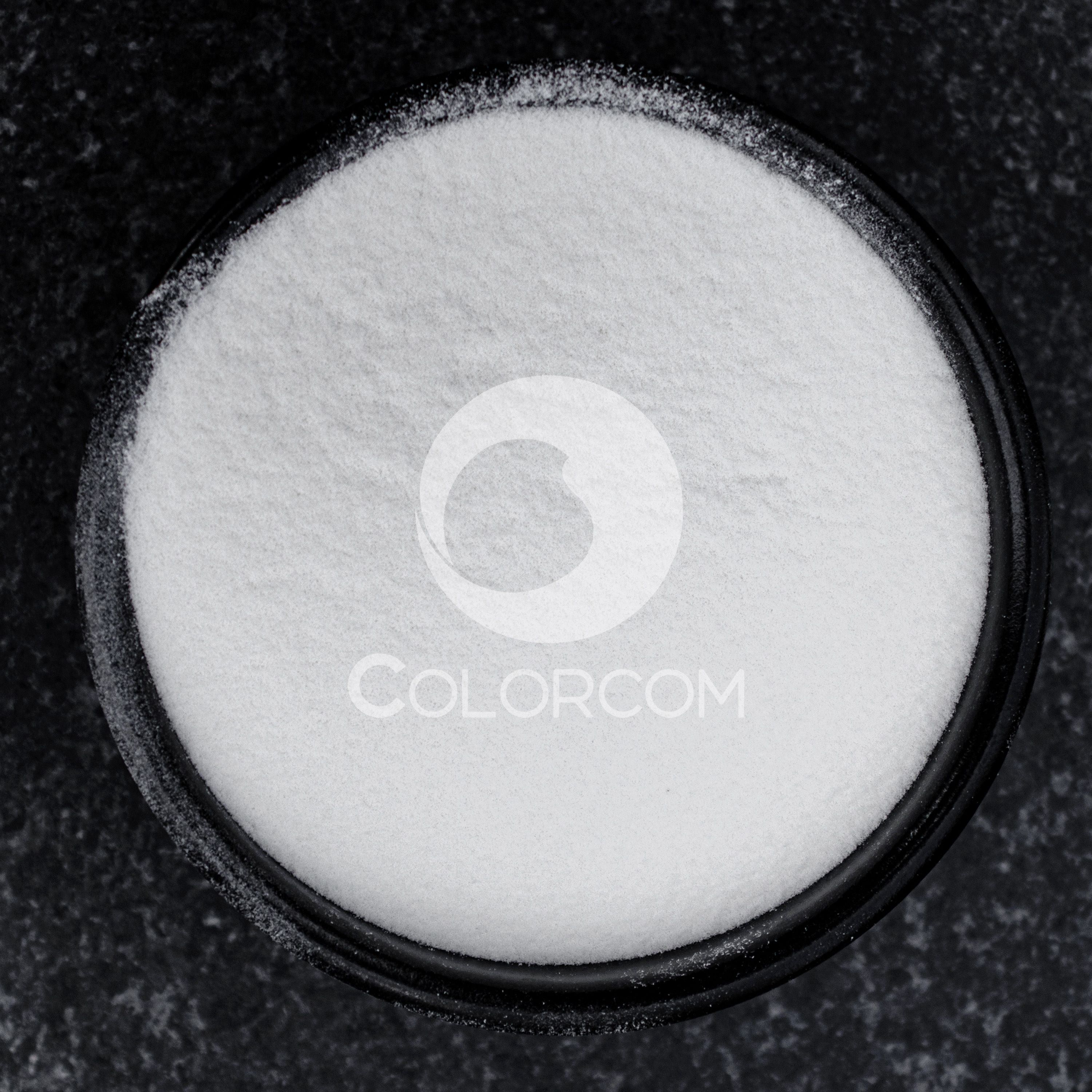Microcrystalline Cellulose | MCC | 9004-34-6
Typical Property:
Moisture content
A number of studies have confirmed that the moisture content of MCC influences compaction properties, tensile strength, and viscoelastic properties. Moisture within the pores of MCC may act as an internal lubricant, reduce frictional forces, and facilitate slippage and plastic flow within the individual microcrystals. The lubricating properties of water may also reduce tablet density variation by providing a better transmission of the compression force through the compact and by decreasing the adhesion of the tablet to the die wall. Compressibility of MCC depends on moisture content, which means that when MCC having different moisture content is compressed with the same pressure, it may not result in the same compact porosity. It is very well known that compaction pressure required to produce certain porosity (or solid fraction) decreases with increasing moisture content. Sun reported that below 3% water content, the compaction properties of MCC were insensitive to variation of moisture. However up to an optimum level, an increase of moisture will increase the tablet strength of most excipients. This can be explained by the fact that molecular binding in water vapor layers reduces interparticular surface distances, hence increasing intermolecular attraction forces.
The storage conditions of the MCC compacts also play an important role, as an increase in relative humidity will negatively impact tablet strength. However this softening is often reversible when tablets are removed from the humid environment. Fundamental forces affecting powder flow are cohesion and friction. Frictional forces and electrostatic charges between particles during the compression process will decrease as moisture content increases. Moisture may also play a role in increasing cohesion forces inside particles due to the creation of liquid or even solid bridges. In the case of MCC as excipient, significant changes in flowability were observed when increasing moisture contents were applied which resulted in changes in powder cohesiveness. This phenomenon was described by the increase in compressibility index and the shear cell.
Particle size
Particle size has a very little effect on the tabletability of neat MCC, i.e., not lubricated nor blended with other excipients or active pharmaceutical ingredients (APIs). MCC particle size and moisture content are often considered as the most important CMAs for tableting performance. Considering that the brittle-ductile transition diameter (Dcrit) of MCC is 1949 mm, standard MCC grades, having particle sizes below Dcrit, should all deform plastically when compression pressure exceeds yield pressure. Coarser grades of MCC, characterized by a smaller envelope surface area, have been reported to be more lubricant sensitive than finer MCC. In complete formulations finer MCCs would therefore promote tablet (compact) strength. Reducing the particle size of MCC will increase cohesiveness and hence as a consequence surely affect its flowability. Kushner et al. reported that different particle sizes of excipient may impact tablet characteristics including hardness, friability, disintegration, and content uniformity. Improved flowability will be obtained when coarser MCCs are employed as well as reduction in tablet weight variation. Hlinak et al. suggested that particle size may also impact wetting properties, dissolution of the API, and stability of drug products.
Albers et al. evaluated the tableting properties of three batches from five different brands MCC type 101. Batches using single manufacturer source produced more similar tablet characteristic than those using samples from various sources. Statistically significant differences were also observed within single brands of MCC. From a different batch of MCC studied, the greatest differences in powder properties were observed in the median particle size and specific surface area. Despite the lower median particle size of Avicel PH-101 (FMC), this MCC was described as easy flowing powder compared to other brands as illustrated by its low compressibility index and high values of shear cell flow functions (FFc) which exceed 4.
Williams et al. used tableting indices to investigate the compaction properties of MCC types 101 and 102 (median particle size of about 50 and 100 mm, respectively), each type being represented by two batches from five different sources. The lubricant sensitivity of MCC expressed as its compressibility decreased when this excipient was mixed with other materials such as magnesium stearate. Another factor affecting lubricant sensitivity of MCC is the particle size. A higher particle size of MCC, Avicel PH-200 (180 microns), is more sensitive to lubricant than Avicel PH-101 (50 microns). At the same concentration, the lubricant covers more efficiently a larger particle size of MCC (PH-200) than that of the smaller particle size of MCC (PH-101) due to a larger particle surface area of smaller particles of MCC .
Compactability of the MCC particles is affected by the porosity. Avicel PH-101, Avicel PH-102, and Avicel PH-200 as marketed products of MCC owing almost the same density showed the same compressibility despite their mean particle size which varies from 50 to 180 microns. Avicel PH-301 (50 microns) and Avicel PH-302 (90 microns) which physically are more dense revealed less compressible or compactable properties [51].
Particle morphology
Obae et al. suggested that MCC morphology, described by the length of particles (L) and their width (D), was one of the most important factors influencing tabletability. Rod-shaped particles which are fibrous and having higher L/D ratios resulted in higher tablet strengths than round-shaped particles. Other physicochemical properties of MCC including moisture content, bulk density, and specific surface area did not correlate well with tensile strength of obtained tablet. Obae et al. illustrated the reduction of bulk density and flowability and the increase of specific surface area when the L/D ratio increased. This may be due to the property of the particles which is more fibrous. MCC morphology was found to be affecting the drug dissolution which may due to porosity.
Crystallinity
Modifying the hydrolysis conditions, including temperature, time, and acid concentration, also has a very little impact on the degree of crystallinity, i.e., the regularity of the arrangement of the cellulose polymer chains. This observation indicates that crystallinity cannot be controlled at the hydrolysis stage. Crystallinity appears to be more dependent on pulp source rather than on processing conditions, which is consistent with the method of MCC manufacture where the acid preferentially attacks the (pulp dependent) amorphous regions.
The total amount of sorbed water in MCC is proportional to the fraction of amorphous material. Therefore MCC powders with a lower degree of crystallinity may contain more water than their counterparts with a higher degree. If low-crystallinity MCC preferentially binds more water, moisture-sensitive APIs may exhibit lower rates of degradation. Despite the controversial impact of crystallinity, it may influence the adsorption of water on cellulose microfibrils, which may in turn influence flowability, tabletability, and stability of the drug product.
Bulk density
Mostly, direct compression excipients are spray-dried; therefore porous structure was produced as a result. This property is characterized by a relatively low bulk density. Increase in porosity (lower density) facilitates higher compressibility, i.e., the densification of a powder bed due to the application of a stress. The improved compressibility of plastically deforming materials, such as MCC, might then result in improved tabletability as a result of the increased bonding surface area. The higher roughness of low density MCC particles may also contribute to particle interlocking. Low bulk density MCC will provide higher dilution potential and hence better counteract the poor tableting properties of APIs. Granulation or drying as preprocesses of tablet formulation will densify MCC hence less tabletable than the original porous MCC. It can therefore be generalized that a decrease in bulk density improves tabletability; however, it will often hinder flowability.
Degree of polymerization
The degree of polymerization (DP) expresses the number of glucose units (C6H10O5) in the cellulose chain. It decreases exponentially as a function of hydrolysis conditions, including temperature, acid concentration, and time of reaction. The rate of hydrolysis slows down to a certain value which is stated as level-off degree of polymerization (LODP). The LODP value is specific for a particular pulp, and it is usually between the range of 200 and 300, e.g., 180–210 range for hardwood pulps and 210–250 for softwood pulps. Theoretically, to obtain a certain degree of polymerization which is higher than the LODP value, hydrolysis process could be terminated at any time. However, due to the exponential decay of DP, this termination is neither a robust nor a reproducible approach. The degree of polymerization is used as an identity test, as pharmacopoeial MCC is defined by a DP below 350 glucose units, compared to DPs in the order of 10,000 units for the original native cellulose [1].
The correlation between the degree of polymerization (DP) of MCC and its tabletability has not been explored yet. Therefore, it is merely an identity test to distinguish the tabletability of MCC (DP < 350) compared with powdered cellulose (DP > 440). Dybowski showed that the origin of the raw materials and the production method of MCC more decisively influence the physical characteristics than DP. DP value is a criterion used to guide the manufacturer about hydrolysis of MCC, whereas for the user it is a characteristic to distinguish between properties of MCC and powdered cellulose.
Wood pulps with high bulk density grades which can be characterized by lower level-off DP should not be directly compared with standard grades. This parameter reflects the lack of distinction between the degree of polymerization (DP) and level-off degree of polymerization (LODP). LODP is typical of a particular raw material, with a common value between the range of 200 and 300 [44]. Cellulose having LODP value at this range usually difficult for further hydrolysis. In contrast, cellulose materials with DP values higher than the level-off degree of polymerization plateau are more difficult to control due to their greater sensitivity to hydrolysis. Owing LODP above 200–300, the MCC remains to be more fibrous, which would result in a lower bulk density, with improved tabletability, but would hinder powder flow. Below the LODP MCC is less fibrous, denser, and less tabletable. Tabletability is not related to a particular DP value; as an example powdered cellulose has a higher DP than MCC but is not as tabletable.
Effect of lignin
Landín et al. compared four brands of MCC. Different woods used as raw materials, i.e., hardwood versus softwood, suggested differences in lignin and hemicelluloses composition. The non-cellulose component has also significantly different manufacturing process intensities which resulted in variable suggestive composition and potentially varying qualities of product. Landín et al. found that lignin content increased the dissolution rate of prednisone. Lignin being hydrophobic may alter cellulose–cellulose and/or cellulose–API interactions and hence drug release rate.
Thoorens et al. studied that differences in packing and flow properties which are shown by scanning electron micrographs from Avicel PH-101 and Avicel PH-102 were attributed to differences in moisture content, particle shape, and particle size distribution. Tabletability which also varied among the MCC samples were attributed to the differences in moisture content and the internal structure of the particles. These are mostly caused by different processing conditions which are specific to each manufacturer. However, the impacts of crystallinity and particle morphology are negligible. Significant differences in lubricant sensitivity, compressibility, and tablet disintegration were also noted between MCCs due to various manufacturing processes by different manufacturers. Variability between lots from the same manufacturer was found to give a smaller effect on properties of MCC product. A current study from Doelker concluded that even if all of various MCCs comply with compendial specifications, large differences still exist among them.
Applications:
Microcrystalline Cellulose is used as Pharmaceutical Excipient.
Moisture content
A number of studies have confirmed that the moisture content of MCC influences compaction properties, tensile strength, and viscoelastic properties. Moisture within the pores of MCC may act as an internal lubricant, reduce frictional forces, and facilitate slippage and plastic flow within the individual microcrystals. The lubricating properties of water may also reduce tablet density variation by providing a better transmission of the compression force through the compact and by decreasing the adhesion of the tablet to the die wall. Compressibility of MCC depends on moisture content, which means that when MCC having different moisture content is compressed with the same pressure, it may not result in the same compact porosity. It is very well known that compaction pressure required to produce certain porosity (or solid fraction) decreases with increasing moisture content. Sun reported that below 3% water content, the compaction properties of MCC were insensitive to variation of moisture. However up to an optimum level, an increase of moisture will increase the tablet strength of most excipients. This can be explained by the fact that molecular binding in water vapor layers reduces interparticular surface distances, hence increasing intermolecular attraction forces.
The storage conditions of the MCC compacts also play an important role, as an increase in relative humidity will negatively impact tablet strength. However this softening is often reversible when tablets are removed from the humid environment. Fundamental forces affecting powder flow are cohesion and friction. Frictional forces and electrostatic charges between particles during the compression process will decrease as moisture content increases. Moisture may also play a role in increasing cohesion forces inside particles due to the creation of liquid or even solid bridges. In the case of MCC as excipient, significant changes in flowability were observed when increasing moisture contents were applied which resulted in changes in powder cohesiveness. This phenomenon was described by the increase in compressibility index and the shear cell.
Particle size
Particle size has a very little effect on the tabletability of neat MCC, i.e., not lubricated nor blended with other excipients or active pharmaceutical ingredients (APIs). MCC particle size and moisture content are often considered as the most important CMAs for tableting performance. Considering that the brittle-ductile transition diameter (Dcrit) of MCC is 1949 mm, standard MCC grades, having particle sizes below Dcrit, should all deform plastically when compression pressure exceeds yield pressure. Coarser grades of MCC, characterized by a smaller envelope surface area, have been reported to be more lubricant sensitive than finer MCC. In complete formulations finer MCCs would therefore promote tablet (compact) strength. Reducing the particle size of MCC will increase cohesiveness and hence as a consequence surely affect its flowability. Kushner et al. reported that different particle sizes of excipient may impact tablet characteristics including hardness, friability, disintegration, and content uniformity. Improved flowability will be obtained when coarser MCCs are employed as well as reduction in tablet weight variation. Hlinak et al. suggested that particle size may also impact wetting properties, dissolution of the API, and stability of drug products.
Albers et al. evaluated the tableting properties of three batches from five different brands MCC type 101. Batches using single manufacturer source produced more similar tablet characteristic than those using samples from various sources. Statistically significant differences were also observed within single brands of MCC. From a different batch of MCC studied, the greatest differences in powder properties were observed in the median particle size and specific surface area. Despite the lower median particle size of Avicel PH-101 (FMC), this MCC was described as easy flowing powder compared to other brands as illustrated by its low compressibility index and high values of shear cell flow functions (FFc) which exceed 4.
Williams et al. used tableting indices to investigate the compaction properties of MCC types 101 and 102 (median particle size of about 50 and 100 mm, respectively), each type being represented by two batches from five different sources. The lubricant sensitivity of MCC expressed as its compressibility decreased when this excipient was mixed with other materials such as magnesium stearate. Another factor affecting lubricant sensitivity of MCC is the particle size. A higher particle size of MCC, Avicel PH-200 (180 microns), is more sensitive to lubricant than Avicel PH-101 (50 microns). At the same concentration, the lubricant covers more efficiently a larger particle size of MCC (PH-200) than that of the smaller particle size of MCC (PH-101) due to a larger particle surface area of smaller particles of MCC .
Compactability of the MCC particles is affected by the porosity. Avicel PH-101, Avicel PH-102, and Avicel PH-200 as marketed products of MCC owing almost the same density showed the same compressibility despite their mean particle size which varies from 50 to 180 microns. Avicel PH-301 (50 microns) and Avicel PH-302 (90 microns) which physically are more dense revealed less compressible or compactable properties [51].
Particle morphology
Obae et al. suggested that MCC morphology, described by the length of particles (L) and their width (D), was one of the most important factors influencing tabletability. Rod-shaped particles which are fibrous and having higher L/D ratios resulted in higher tablet strengths than round-shaped particles. Other physicochemical properties of MCC including moisture content, bulk density, and specific surface area did not correlate well with tensile strength of obtained tablet. Obae et al. illustrated the reduction of bulk density and flowability and the increase of specific surface area when the L/D ratio increased. This may be due to the property of the particles which is more fibrous. MCC morphology was found to be affecting the drug dissolution which may due to porosity.
Crystallinity
Modifying the hydrolysis conditions, including temperature, time, and acid concentration, also has a very little impact on the degree of crystallinity, i.e., the regularity of the arrangement of the cellulose polymer chains. This observation indicates that crystallinity cannot be controlled at the hydrolysis stage. Crystallinity appears to be more dependent on pulp source rather than on processing conditions, which is consistent with the method of MCC manufacture where the acid preferentially attacks the (pulp dependent) amorphous regions.
The total amount of sorbed water in MCC is proportional to the fraction of amorphous material. Therefore MCC powders with a lower degree of crystallinity may contain more water than their counterparts with a higher degree. If low-crystallinity MCC preferentially binds more water, moisture-sensitive APIs may exhibit lower rates of degradation. Despite the controversial impact of crystallinity, it may influence the adsorption of water on cellulose microfibrils, which may in turn influence flowability, tabletability, and stability of the drug product.
Bulk density
Mostly, direct compression excipients are spray-dried; therefore porous structure was produced as a result. This property is characterized by a relatively low bulk density. Increase in porosity (lower density) facilitates higher compressibility, i.e., the densification of a powder bed due to the application of a stress. The improved compressibility of plastically deforming materials, such as MCC, might then result in improved tabletability as a result of the increased bonding surface area. The higher roughness of low density MCC particles may also contribute to particle interlocking. Low bulk density MCC will provide higher dilution potential and hence better counteract the poor tableting properties of APIs. Granulation or drying as preprocesses of tablet formulation will densify MCC hence less tabletable than the original porous MCC. It can therefore be generalized that a decrease in bulk density improves tabletability; however, it will often hinder flowability.
Degree of polymerization
The degree of polymerization (DP) expresses the number of glucose units (C6H10O5) in the cellulose chain. It decreases exponentially as a function of hydrolysis conditions, including temperature, acid concentration, and time of reaction. The rate of hydrolysis slows down to a certain value which is stated as level-off degree of polymerization (LODP). The LODP value is specific for a particular pulp, and it is usually between the range of 200 and 300, e.g., 180–210 range for hardwood pulps and 210–250 for softwood pulps. Theoretically, to obtain a certain degree of polymerization which is higher than the LODP value, hydrolysis process could be terminated at any time. However, due to the exponential decay of DP, this termination is neither a robust nor a reproducible approach. The degree of polymerization is used as an identity test, as pharmacopoeial MCC is defined by a DP below 350 glucose units, compared to DPs in the order of 10,000 units for the original native cellulose [1].
The correlation between the degree of polymerization (DP) of MCC and its tabletability has not been explored yet. Therefore, it is merely an identity test to distinguish the tabletability of MCC (DP < 350) compared with powdered cellulose (DP > 440). Dybowski showed that the origin of the raw materials and the production method of MCC more decisively influence the physical characteristics than DP. DP value is a criterion used to guide the manufacturer about hydrolysis of MCC, whereas for the user it is a characteristic to distinguish between properties of MCC and powdered cellulose.
Wood pulps with high bulk density grades which can be characterized by lower level-off DP should not be directly compared with standard grades. This parameter reflects the lack of distinction between the degree of polymerization (DP) and level-off degree of polymerization (LODP). LODP is typical of a particular raw material, with a common value between the range of 200 and 300 [44]. Cellulose having LODP value at this range usually difficult for further hydrolysis. In contrast, cellulose materials with DP values higher than the level-off degree of polymerization plateau are more difficult to control due to their greater sensitivity to hydrolysis. Owing LODP above 200–300, the MCC remains to be more fibrous, which would result in a lower bulk density, with improved tabletability, but would hinder powder flow. Below the LODP MCC is less fibrous, denser, and less tabletable. Tabletability is not related to a particular DP value; as an example powdered cellulose has a higher DP than MCC but is not as tabletable.
Effect of lignin
Landín et al. compared four brands of MCC. Different woods used as raw materials, i.e., hardwood versus softwood, suggested differences in lignin and hemicelluloses composition. The non-cellulose component has also significantly different manufacturing process intensities which resulted in variable suggestive composition and potentially varying qualities of product. Landín et al. found that lignin content increased the dissolution rate of prednisone. Lignin being hydrophobic may alter cellulose–cellulose and/or cellulose–API interactions and hence drug release rate.
Thoorens et al. studied that differences in packing and flow properties which are shown by scanning electron micrographs from Avicel PH-101 and Avicel PH-102 were attributed to differences in moisture content, particle shape, and particle size distribution. Tabletability which also varied among the MCC samples were attributed to the differences in moisture content and the internal structure of the particles. These are mostly caused by different processing conditions which are specific to each manufacturer. However, the impacts of crystallinity and particle morphology are negligible. Significant differences in lubricant sensitivity, compressibility, and tablet disintegration were also noted between MCCs due to various manufacturing processes by different manufacturers. Variability between lots from the same manufacturer was found to give a smaller effect on properties of MCC product. A current study from Doelker concluded that even if all of various MCCs comply with compendial specifications, large differences still exist among them.
Applications:
Microcrystalline Cellulose is used as Pharmaceutical Excipient.











